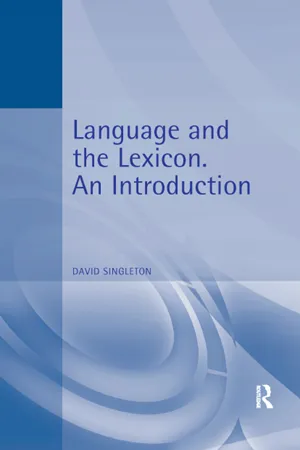Inflectional Morphemes
Inflectional morphemes are affixes added to a word to indicate grammatical information such as tense, number, case, and gender. They modify the meaning of a word without changing its basic meaning or part of speech. In English, examples of inflectional morphemes include the -s for plural nouns and the -ed for past tense verbs.
6 Key excerpts on "Inflectional Morphemes"
- eBook - ePub
Language and the Lexicon
An Introduction
- David Singleton(Author)
- 2016(Publication Date)
- Routledge(Publisher)
...Rather, they make small adjustments to words which have important grammatical consequences – signalling, for instance, tense, person and number in verbs, and number and grammatical case in nouns. The following examples, from various languages, provide further illustration of these various roles. Present-past distinction in German: er leb t (‘he lives’) vs. er lebt e (‘he lived’) First person-second person distinction in Spanish: regres o (‘I return’) vs. regres as (‘you (sing.) return’) regres amos (‘we return’) vs. regres ais (‘you (plur.) return’) Singular plural distinction in French: elle chanter a (‘she will sing’) vs. elles chanter ont (‘they (fem.) will sing’) Singular-plural distinction in Swedish: apelsin (‘orange’) vs. apelsin er (‘oranges’) Nominative (subject case) vs. genitive (possessive case) in Modern Greek: to ner ó (τo νερ ó – ‘the water’) vs. tu ner ú (του νερ óυ – ‘of the water’, ‘the water’s’) Because of the grammatical nature of their contribution to word-structure, and because, at first sight at least, they seem to be assignable by rule rather than dependent on the particularities of lexical items, Inflectional Morphemes have been considered by some linguists to lie outside the domain of the lexicon and to belong rather with the grammatical rules of a language. We have seen already, with regard to syntax, that making a hard and fast distinction between lexicon and grammar is no easy task. In the case of morphology, as will become clear in the next section, such a distinction makes no sense whatsoever. 3.4 Inflectional Morphemes and the lexicon A first very basic problem about a claim that derivational morphemes are lexicon-based while Inflectional Morphemes are not is that it is not at all clear in some instances whether a particular morpheme is derivational or inflectional...
- David Hornsby(Author)
- 2014(Publication Date)
- Teach Yourself(Publisher)
...Building words: morphology In the two previous chapters we have considered the basic building blocks of language (phonemes) and the ways in which they can be combined in speech. Our focus in this chapter and the next will be on grammar, which linguists have traditionally seen as comprising the two sub-disciplines of syntax, the arrangement of words in a sentence, which we explore in Chapter 6, and morphology, the internal structure of words, which we examine here. We begin by introducing the concept of the morpheme, which often proves a more helpful analytical tool than the word, a satisfactory definition of which proves elusive. We then review the traditional division between derivational morphology (or word formation) and inflectional morphology (the marking of grammatical categories), and look at attempts to classify languages on the basis of their morphological structure. We close the chapter by looking more closely at grammatical categories such as number and gender and their values, which prove extremely variable cross-linguistically and often differ greatly from those which are familiar to us as English speakers. Words and morphemes Languages differ more in morphology than in syntax. The variety is so great that no simple scheme will classify languages as to their morphology. One such scheme distinguishes analytic languages, which use few bound forms, from synthetic, which use many...
- eBook - ePub
Linguistics for Language Teachers
Lessons for Classroom Practice
- Sunny Park-Johnson, Sarah J. Shin(Authors)
- 2020(Publication Date)
- Routledge(Publisher)
...This chapter will show how knowledge of the principles of word formation can facilitate students’ learning of new vocabulary and what teachers can do to help students acquire this knowledge. 4.2 Morphemes The most important part of the word is the morpheme, the smallest linguistic unit with a meaning or a grammatical function. Morphemes are important because all languages use them as building blocks to construct words. The word teacher, for example, consists of two morphemes: teach (with the meaning of “give instruction in”) and -er (which indicates that the whole word functions as a noun with the meaning “one who teaches”). Similarly, the word schools is composed of the morphemes school (with the meaning of “an institution where instruction is given”) and -s (with the meaning “more than one”). Some words are made up of a single morpheme. Such words are said to be simple words. For example, the word happy cannot be divided into smaller parts that carry information about its meaning or function. Thus, the word happy consists of a single morpheme. In contrast, the word impersonal is made up of three morphemes, im-person-al. Words that contain two or more morphemes like impersonal are said to be complex words. It is important to not confuse morphemes with syllables. The word happy [hæ.pi] is one morpheme but has two syllables. The word impersonal [ɪm.pʌr.sə.nəl] is composed of three morphemes but has four syllables (note that the “.” in the phonetic transcriptions marks syllable boundaries). Remember that a morpheme is the smallest linguistic unit with a meaning or a grammatical function. Complex words typically consist of a root morpheme and one or more affixes. The root is the primary lexical unit of a word that carries the most significant aspects of semantic content and cannot be reduced into smaller parts...
- eBook - ePub
Applying Linguistics in the Classroom
A Sociocultural Approach
- Aria Razfar, Joseph C. Rumenapp(Authors)
- 2013(Publication Date)
- Routledge(Publisher)
...6 Morphology Building Words with English Learners Learning Goals Summarize the basic concepts of morphology. Identify morphological processes. Understand different types of morphological systems in the world’s languages. Understand the difficulties ELs may have in learning English morphology. Use derivational and inflectional rules in the classroom. Create a case study to analyze a particular topic in morphology. Use morphological concepts in discourse analysis. KEY TERMS/IDEAS: morpheme, lexeme, lexicon, derivation, inflection, agglutinating, fusional, isolating, nominalization In Chapter 5 we discussed the syntax, or grammar of language. Morphology is a related field in linguistics. Sometimes it is very difficult to distinguish what belongs to syntax and what belongs to morphology because there is much overlap. What one language does in syntax, like through changes in word order as seen in the last chapter, another may do through morphology, by changing the word itself. Therefore, it is often better to think about both fields together, as morphosyntax. In Chapter 5, we focused more on how words (in the discrete analytic sense) relate to each other. In this chapter, we will examine how words are built internally to create distinct meaningful units. Morphology is the study of a language’s morphemes and the rules governing its transformations for communicative purposes. Morphemes consist of words, affixes, intonation, stress, and their implied or explicit contexts of use. In this chapter we will see how the traditional concept of “word,” especially in the isolated sense, constrains our view of how we learn, develop, and actually use language to make meaning. As we learn about the ELs in our classrooms, we need to be aware of the complexities of languages in the world. If we look at language only through our “English eyes” we will certainly misunderstand the way language is used by ELs...
- eBook - ePub
- Kristin Denham, Anne Lobeck(Authors)
- 2018(Publication Date)
- Routledge(Publisher)
...Other languages have agentive morphemes too. American Sign Language, for example, has an agentive morpheme which turns verbs like TEACH into nouns like TEACHER. Inflectional affixes do not change the category of the word they attach to, nor do they create new dictionary entries. Instead, they express grammatical information, such as tense, gender, number, case, and other features. English has relatively little inflectional morphology, compared to other more highly inflected languages. In fact, in English there are only eight inflectional affixes, though three of them are the suffix -s, which displays three distinct functions. Nouns possessive -s plural - s Mo ’s book book s Adjectives comparative -er superlative -est Mo is tall er. Mo is tall est. Verbs 3rd person singular past tense present participle past participle Mo walk s Mo walk ed Mo is walk ing Mo has walk ed Mo has eat en In comparison, Old English (OE) was highly inflected. The following comparison of inflectional affixation of the verb love provides an example. In Present Day English (PDE), the verb has no inflectional affixation in the present tense except in the third person singular (loves), but in OE there are four distinct suffixes (note also the different forms of the personal pronouns): Table 4.1 Conjugation of the verb ‘love’ in PDE and OE Present Day English Old English I love ic luf ie you love þu luf ast he/she loves heo luf aþ we love we luf iaþ you love ge lufiaþ they love hie lufiaþ Although in English, derivational affixes are either prefixes or suffixes, and inflectional affixes are suffixes only, in other languages affixes can be infixes and circumfixes...
- eBook - ePub
A Comparative Typology of English and German
Unifying the Contrasts
- John Hawkins(Author)
- 2015(Publication Date)
- Routledge(Publisher)
...2 Grammatical Morphology DOI: 10.4324/9781315687964-2 In this chapter some important differences in morphology between English and German are considered with particular reference to Inflectional Morphemes. Some related general contrasts in derivational morphology and lexical semantics will also be discussed. The main focus of attention will be the case system of German, the semantic and syntactic conditions associated with the uses of the different cases, and the semantic consequences of the loss of inflectional morphology in the history of English. 2.1 Inflectional Morphology: A Contrastive Overview German has richer inflectional morphology than English. In general, all the grammatical distinctions that are drawn within English inflectional morphology are drawn in German as well, though not vice versa. For example, both English and German express a singular/plural distinction on their nouns (E. book/books ; G. Buch/Bücher). Verbs express a past/present tense distinction (E. say/said ; G. sage/sagte). And third person singular pronouns distinguish masculine/feminine/neuter forms (E. he/she/it ; G. er/sie/es). In these three examples the set of grammatical distinctions drawn in English is identical to that drawn in German. But there are numerous grammatical distinctions that are drawn in German inflectional morphology which are not drawn in English. German has Inflectional Morphemes distinguishing four cases within the noun phrase, nominative, accusative, genitive, dative (cf. der Mann, den Mann, des Mannes, dem Mann(e) respectively). English has collapsed its nominative, accusative and dative forms into a common the man, though it still retains a separate genitive the man’s. The definite article the is invariable (as are adjectives). English therefore has two surface cases where German has four. German still has an indicative/subjunctive distinction in its verb, whereas English employs a single form for both (cf...





